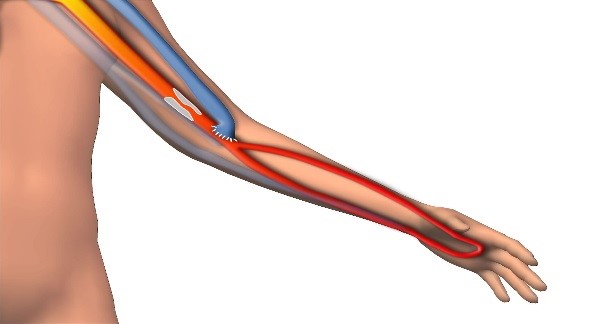The most common source of infection in patients with uremia comes from vascular access. In patients receiving long-term hemodialysis, the most common causes of hospitalization are vascular access related complications including partial or complete access stenosis or obstruction. Vascular access has a limited longevity, with survival rates between 1.5 and 2 years in average.
Vascular access care should begin as soon as the patient is admitted to the hospital. These patients who may need long-term hemodialysis should immediately determine which limb will undergo vascular surgery and avoid the treatment and blood withdrawal of the limb.
Care and precaution of arteriovenous fistula
Avoid compression
- Start to exercise your fistula arm 2 to 7 days after surgery.
- Avoid heavy lifting or carrying heavy loads with your fistula arm
- Avoid sleeping on your arm in which vascular access is created
- Do not wear watch or accessory on your fistula arm
- Do not take blood pressure measurements, have any blood tests taken, or receive needles or infusions from your fistula arm
- Do not wear any tight or restrictive clothing on your fistula arm
Prevention of infection
- Thoroughly clean and sanitize your fistula arm before hemodialysis.
- Avoid scratching the fistula arm. If you develop pain, redness, or the skin around your fistula becomes hot, please tell your nurse or doctor immediately.
- Avoid bathing if the wound is not healed or after dialysis. When bathing, you must be careful not to get wet at the puncture wound.
- If the dressing gauze is wet, contaminated, or blood-stained, the puncture wound must be re-dressed with new gauzes and tapes.
- The gauze covering the puncture wound must be removed the next day to dry the wound.
- If there are signs of infection such as redness, swelling, heat and pain in the puncture wound, you should seek medical treatment immediately.
- Self-check for symptoms of infection
Signs of stenosis
- You cannot feel a vibration (‘thrill’) when checking fistula.
- There is mild pain or the blood vessels have a hard touch which hard to the touch, which is a little different than usual.
- Once the signs of vascular obstruction are found, please contact the staff for further examination and treatment by cardiologist or cardiovascular surgeon.
How to Check
- Place your fingers on the skin over your fistula; you should feel a vibration (‘thrill’). Listen for the ‘shoosh-shoosh’ noise (‘bruit’) made by your fistula. You should check once a day that your fistula is working.
- Signs of stenosis: you cannot feel thrill or listen for bruit.


